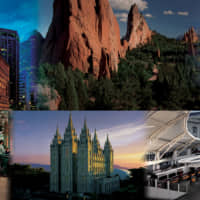Over several decades, Japanese investment gravitated towards certain corners of the United States for various reasons: Japan’s proximity to California, the concentration of banks and financial firms in New York, the strength of manufacturing in the South and Midwest, and the indisputable reputation of Cambridge, Massachusetts and Silicon Valley as hotbeds of innovation.
While particular regions have established deep ties with Japanese companies, investors from Japan remain focused on finding new growth areas in the United States.
Collectively identified as The Mountain States, Arizona, Colorado, Nevada, New Mexico, Utah and Wyoming are carving out their own niches and building their own unique selling points to attract more foreign investment.
Inbound Japanese FDI in the U.S. has doubled since 2002. JETRO’s 2018 company survey of U.S.-based Japanese executives points out that 54% of Japanese companies already in the U.S. have plans to expand.
For this new wave of Japanese investors, many of them start-ups or small and medium-sized enterprises, the strict regulatory regimes, lack of open land and the high operating costs in the tried-and-tested East and West Coasts make their ventures infeasible.
And these are the investors eager to contribute to the Japanese government’s “Society 5.0” project – a vision of the world where smart cities. self-driving electric cars, robots and artificial intelligence dominate.
So, these new pioneers have come to the Southwest and Mountain states, a region that invokes images of vast spaces and a history of risk-taking Americans exploring the New Frontier.
“We are so lucky to have a very active Japanese-American community here. As of October 2019, there were 9,276 Japanese citizens. And this number has been increasing, which is a very good sign,” said Consul General of Japan in Denver Midori Takeuchi, whose office oversees the states of Colorado, New Mexico, Utah, and Wyoming.
Having celebrated its 30th anniversary last year, the Japan America Society (JAS) of Colorado has seen its membership double since the launch of nonstop flights between Denver International Airport and Tokyo Narita Airport in 2013.
“Because of the nonstop flight, existing Japanese investors have expanded their operations and many startups have seen the benefits of setting up shop in the Denver Metro Area,” said JAS Colorado Executive Director Claudine Locascio.
Highlighting the advantages of the state, Colorado Gov. Jared Polis said: “Colorado is one of the best places to do business. We work hard to keep unemployment low, grow our technology sector, develop a talented and educated workforce and ensure our state is business and innovation friendly. These are values we share with Japan.”
“We enjoy a strong partnership with Japan, our fourth-largest trade partner. Currently, we have about 14 Japanese FDI projects and about 50 Japanese companies that account for more than 7,000 high quality, high-paying jobs. We look forward to growing that number and continuing our mutually beneficial relationship,” Polis added.
Unknown to many, Utah has nurtured a strong relationship with Japan. Trade between the two has more than doubled over the past five years and, as of 2017, was valued at $811 million. With both sides displaying an edge in innovation, the aerospace, life sciences and energy sectors have attracted the most attention from investors.
“There are always opportunities for additional collaboration between Utah and Japan, particularly in the areas of innovation, trade partnerships, technology collaboration and cultural exchange. Our state experienced record-breaking international success in trade numbers by looking beyond our borders and encouraging direct foreign investment in our great state,” said Utah Gov. Gary Herbert, who led a successful trade mission to Japan last September.
Wyoming, while mostly known as the least populous state, is also the 10th largest in America by area. With an abundance of energy resources, Wyoming produces 15 times more energy than it consumes, making it the biggest net energy supplier among all the states.
Meanwhile, Nevada has also seen a rise in the number of companies wanting to relocate to the state.
“The cost of doing business in California is the biggest factor why companies relocate here. They realize that they do not necessarily lose their speed-to-market advantage. A majority of relocation decisions rests on northern Nevada’s strategic location. Our trucks can deliver goods to 60 million inhabitants within a day’s drive,” Northern Nevada Development Authority President and CEO Robert Hooper said.
Home to Los Alamos National Laboratory and Sandia National Laboratories, innovation is embedded in the culture of New Mexico. In the southern part of the state is the world’s first purpose-built commercial spaceport—Spaceport America. With Virgin Galactic as its anchor tenant, the spaceport can accommodate both vertical and horizontal launches.
“We are the birthplace of innovation. We do things differently and that’s the identity of New Mexico. Under the leadership of the Governor Michelle Grisham, we have focused on investing in clean energy, film and TV, infrastructure and education,” said New Mexico Economic Development Department Division Director Mark Roper said.
Famous for its natural beauty and tourist sights, Arizona has created waves in the technology and educational sectors. Institutions like Tech Parks Arizona, overseen by the University of Arizona, have set up incubation spaces targeted solely at small-to-midsized businesses.
With strong support and encouragement from their government, more Japanese companies have realized the compelling need to tap overseas markets to achieve long-term growth and have had to work more closely with American universities, companies and local economic development groups to develop research and recruit talent.
Another development in the United States welcomed by SMEs and startups is the rapid growth of fab labs (or fabrication laboratories), which offer personal and small-scale digital fabrication. This “maker movement,” which is spreading across the world, is beginning to take root in the Southwestern states.
“I invite many to come and find out the beauty of the region. Every state has a distinct character, and it will truly open your eyes to what the country has to offer,” said Takeuchi.



